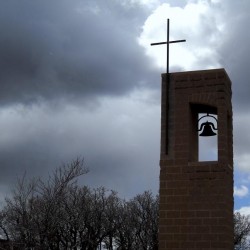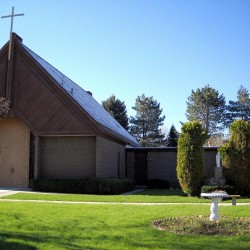Listening for the quiet call to religious life in Utah
May 4th, 2011 Posted in Arts and LifeIt’s a simple lifestyle that has always been a small piece of the “31 flavors” of religious orders in the Catholic church.
Story and photos by Lis Stewart
OGDEN — Ever since she was five years old, Sister Danile Knight said she knew she wanted to be a nun. “I never wanted to be anything else,” she said.
Growing up a block away from a convent in Minneapolis, Minn., Knight would watch the Benedictine sisters walk past her house every night on the way back to the convent. “A lot of times I’d go and walk with them for a few blocks so I got to know most of them that way,” Knight said.
“I wanted to be one of them because I liked what I saw.” She is now a Benedictine nun living in Ogden, Utah.
In recent years, Catholic monasteries that have become cultural icons in places like Utah are seeing a decline in new members. A number of monasteries across the United States are shrinking out of existence because many monks and nuns who reach retirement age will never be replaced.
In Huntsville, the monks’ low, melodic chants echoed off the curved walls and ceiling of the chapel at the Abbey of Our Lady of the Holy Trinity. Up and down, over and under, the nine monks’ voices were not all quite in tune as they sang the same simple praises most of them have sung for at least 30 years, but their dedication was sincere.
“God doesn’t call us according to the configuration of our larynxes,” Rev. David Altman said. “So we have guys that can sing—thank heaven—and we have guys that can’t.”
===
It is the call of God that brings many people out of the world and into monasteries like the abbey in Huntsville, and fewer are hearing that call than before, Altman said.
“There’s so much noise out there,” he said. “So many competing forces. Do this and do that, and advertising, and computers. When I came (to the monastery) we didn’t have to put up with that. But all those things are drowning out the subtlety of the divine call from God.”
Altman is the abbot of the abbey in Huntsville, whose monks are commonly known as Trappists. The monks have distinguished themselves in the region over the last 64 years for their expertise in practices such as farming, ranching, and baking, most of which the monks can no longer do themselves.
This summer, one of the last hallmarks of the Huntsville Trappists will be phased into mere local memory forever: their honey. Why? “Done run out of monks,” Altman said. There are 15 monks still alive at the monastery, and their average age is 81.
 “What’s going to happen in the future? I don’t know,” Altman said. “If things go like they are, then the monastery will eventually have to close and the remaining monks would be dispersed to other monasteries.”
“What’s going to happen in the future? I don’t know,” Altman said. “If things go like they are, then the monastery will eventually have to close and the remaining monks would be dispersed to other monasteries.”
The Trappists are not the only Catholic religious order in Utah having trouble finding new members. Mount Benedict Monastery in South Ogden is down to six sisters.
Mount Benedict remains active, and several sisters still work at St. Benedict’s Hospital in Ogden. The sisters also run a charitable foundation to provide financial assistance to other organizations. Sister Danile Knight said the foundation helps more than 8,000 women and children yearly.
“We are only six sisters here, but with the foundation we can touch many, many lives,” Knight said.
Knight, who now serves as house coordinator at the South Ogden monastery, came to Utah in 1964. At the time there were 30 sisters at Mount Benedict. She said many young women are ignoring the divine call because of new distractions in today’s world. “God is speaking to us but we’re not listening,” she said.
Knight remains optimistic. There have been periods of decline before, and who knows what God has in store, she said. Life is a circle and history has a way of repeating itself. “Who knows what might happen,” she said. “God is still calling.”
In the meantime, the sisters at Mount Benedict have made preparations for the day the monastery will close. In 2009, they merged with the monastery the nuns originally came from in Minnesota.
“I said to the sisters, ‘We need to do something about our future,’ –- because we weren’t getting members — ‘and so we have to do something about our future as Mount Benedict Monastery,’” Knight said.
===
To be a nun or a monk in today’s world takes a special sort of person, said Rev. Bob Bussen, the priest who is temporary administrator at St. Thomas Aquinas Church in Hyde Park until the end of May.
At the end of WWII Catholic monasteries saw a dramatic increase in new members because of disillusionment and the influence of the biography of Thomas Merton, a monk who said he found peace in life at a monastery. The problem arising now, Bussen said, is that the sudden influx of new monks and nuns was just a bubble, and many of the monasteries built to house them are starting to close because there are fewer new members to replace them. “It’s a little like Social Security,” he said.
Ask a sister or monk why they joined the monastic life and they will say they joined because they heard a divine call—a vocation. It is a divine call from God to a life of prayer, and in many orders, work. It’s a simple, quiet lifestyle that has always been a small piece of the “31 flavors” of the various religious orders in the church, Bussen said.
“Their lifestyle to us sounds terribly difficult,” Bussen said. “Like a real hardship. And they see it as very good, very nice. They like it.” 
Soft spoken and gentle, Mother Maureen Goodwin, prioress of Carmel of the Immaculate Heart of Mary Monastery in Salt Lake City, said a contemplative vocation is a lifelong commitment.
The nuns at the Carmelite monastery in Salt Lake spend their whole lives in prayer for the world. The nuns’ income comes from baking altar breads and largely from the Carmelite Fair they hold yearly, where food, toys, handicrafts, and donated goods are sold.
“The rest of the year we live here, and we work, and we pray,” Goodwin said.
Goodwin entered the life in 1950. Two years later she came to Utah with other sisters from the Carmelite monastery in Alhambra, Calif., to form a monastery at the invitation of former Bishop of Salt Lake City, Duane Hunt.
Goodwin said there are not a lot of young woman coming to join the nuns at the monastery, but still there are some. “A young woman asks to join us if she has a special call (a vocation from God) and only then is she able to live the life in the monastery.”
Bussen said the Carmelites’ monastery is sustainable.
“It’s a very rarified lifestyle and there are few people that would be able to live it,” he said. “But they do have young women that are interested that do come and join their monastery.”
For Goodwin, the work of the Carmelites was an important factor in her decision.
“I wanted to give my life to God and to pray for souls and to praise God for the rest of my life,” she said.
NW
Tags: Catholic, monasteries, monks, nuns, religious calling, Utah

Sorry, comments for this entry are closed at this time.